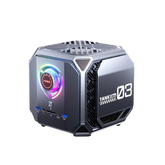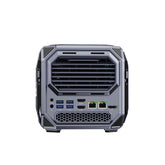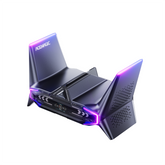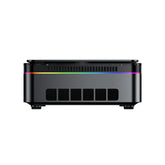SSD vs HDD: Understanding the Key Differences for Your Storage Needs
In everyday computer usage, many of us encounter issues like sudden lag, slow game load times, and lengthy file transfer durations. These annoyances are often due to storage device "bottlenecks." The storage device not only affects system boot times but also impacts application loading, game performance, and file storage. When it comes to storage solutions, SSDs (Solid State Drives) and HDDs (Hard Disk Drives) are the most common choices. Each has its pros and cons, catering to different needs and budgets.
So, how does your choice of storage device truly affect your user experience? Do you fully understand the differences between SSD and HDD? In this article, we will explain the differences between these two popular storage devices, helping you make a smarter decision when buying—whether you're looking to boost system performance or store large amounts of data. We will provide practical buying advice to meet your needs.
1.What are HDD and SSD?
1.1 HDD (Hard Disk Drive)
An HDD (Hard Disk Drive) is a traditional magnetic storage device, with its operating principle similar to a vinyl record. Inside an HDD, there are multiple spinning disks (called platters), and data is read or written by the read/write head moving across the disk surface. The head's movement is like the stylus on a vinyl record, accessing data. Key parameters for HDDs include rotational speed and interface. Common rotational speeds are 5400 RPM (revolutions per minute) and 7200 RPM. The higher the RPM, the faster the data access speed. HDDs typically connect via a SATA interface, which is slower compared to modern interfaces, making it suitable for applications that require large storage capacities but don’t demand high-speed data access.

1.2 SSD (Solid State Drive)
Unlike HDDs, SSDs (Solid State Drives) use NAND flash memory chips to store data, with no moving parts. Data is accessed electronically, resulting in extremely high read and write speeds, especially when it comes to booting operating systems and running applications. SSDs come in two main types: SATA SSDs and NVMe SSDs. SATA SSDs use the SATA interface, which offers relatively slower transfer speeds. In contrast, NVMe SSDs connect via PCIe lanes, utilizing high-speed data channels to provide significantly faster transfer speeds—especially in high-performance applications.
Additionally, the type of NAND flash used in an SSD greatly impacts its performance and lifespan. Common types include TLC (Triple-Level Cell) and QLC (Quad-Level Cell). TLC generally has a longer lifespan than QLC, as each storage cell in TLC stores three bits of data, while QLC stores four. This means that QLC has fewer write cycles, resulting in a lower endurance. For example, a TLC SSD might support 600TB of writes, while a QLC SSD might only support 300TB of writes. This makes TLC SSDs a more durable choice over extended use, with a lower risk of data loss.
2. Comprehensive Comparison Between SSD and HDD

2.1 SSD vs HDD Speed (The Most Significant Difference)
| Metric | SSD | HDD |
|---|---|---|
| Boot Time | 10 seconds (almost instant system boot) | 1 minute (slower due to mechanical parts) |
| File Transfer Speed | NVMe SSD: up to 7000MB/s | HDD: about 250MB/s (limited by rotational speed) |
| Game Load Time | Cyberpunk 2077 scene load: around 7 seconds | Cyberpunk 2077 scene load: around 40 seconds |
- Boot Time: SSDs almost boot instantly, loading the operating system in just a few seconds. In contrast, HDDs are slower due to their mechanical parts needing to spin and seek data, typically taking over a minute to boot.
- File Transfer Speed: NVMe SSDs can achieve speeds up to 7000MB/s, far surpassing the 250MB/s of HDDs. This is especially noticeable in large file transfers and high-frequency read/write operations, where SSDs shine.
- Game Load Time: For example, in Cyberpunk 2077, an SSD can load scenes in about 7 seconds, while an HDD takes around 40 seconds— a significant difference in performance.
2.2 SSD vs HDD Durability
| Metric | SSD | HDD |
|---|---|---|
| Shock Resistance | Excellent (no moving parts, shock-resistant) | Poor (mechanical parts prone to damage) |
| TBW Metric | 1TB SSD TBW: 600TB write capacity, 160GB/day for 5 years | No clear metric (depends on mechanical durability) |
| Laptop Drop Case | No parts damaged, data safer | Hard drive prone to damage, higher data loss risk |
- Shock Resistance: SSDs, with no moving parts, are more shock-resistant, making them ideal for portable devices like laptops. In contrast, HDDs are susceptible to damage from drops or vibrations, leading to mechanical failure or data loss.
- TBW Metric: SSD durability is typically measured by TBW (Total Bytes Written), for instance, a 1TB SSD might provide 600TB of write capacity, meaning you could write 160GB per day for five years. HDDs lack this kind of measurable durability metric, as their lifespan depends on mechanical parts.
2.3 SSD vs HDD Capacity and Price
| Metric | SSD | HDD |
|---|---|---|
| 1TB Market Price | Around $50 | Around $40 |
| Cost-Effectiveness for High Capacity | Large-capacity SSDs are dropping in price annually but still cost more than HDDs | HDDs remain more cost-effective for capacities of 4TB and higher |
- 1TB Market Price: Currently, the price of a 1TB SSD is around $50, while a 1TB HDD is approximately $40. SSDs are still more expensive, but their prices are steadily dropping over time.
- Cost-Effectiveness for High Capacity: For storage needs above 4TB, HDDs are still more cost-effective. While SSD prices are decreasing, HDDs remain the better option for large-scale storage.
2.4 SSD vs HDD Noise and Power Consumption
| Metric | SSD | HDD |
|---|---|---|
| Noise | Completely silent (no moving parts) | Noise during operation: around 35dB |
| Power Consumption | Lower (can save 50%-70% of power) | Higher (needs to power spinning disks and mechanical arms) |
| Laptop Battery Life | Extends by 0.5-1 hour | No significant impact (may consume more power due to mechanical parts) |
- Noise: SSDs have no moving parts and therefore run completely silently, making them ideal for noise-sensitive environments. In contrast, HDDs generate noise from spinning disks and moving mechanical arms, typically around 35dB.
- Power Consumption: SSDs consume less power, usually between 50%-70% less than HDDs. This results in a noticeable increase in laptop battery life, extending it by 0.5-1 hour. On the other hand, HDDs have higher power consumption because they require energy to drive mechanical parts.
3. SSD vs HDD: Buying Decision Guide
3.1 Scenarios Where SSD is a Must-Have
| Scenario | Reason | Recommended Models |
|---|---|---|
| Ultrabooks/2-in-1 Devices (Space-Saving) | SSDs are compact, lightweight, and have no moving parts, making them ideal for devices that require space efficiency | For example: Samsung 970 EVO Plus, Crucial P3 |
| Video Editing/3D Rendering (High Read/Write Speed) | SSDs have high read/write speeds, which significantly accelerate large file transfers, improving rendering performance | For example: Samsung 970 PRO, WD Black SN850 |
| Gaming (Reduced Lag and Faster Load Times) | SSDs reduce load times, greatly improving gaming experience, especially for large games and high-resolution graphics | For example: Intel 670P, Seagate FireCuda 530 |
- Ultrabooks/2-in-1 Devices: These devices typically require a combination of portability and efficiency. SSDs, with no mechanical parts and a smaller form factor, are perfect for these use cases.
- Video Editing/3D Rendering: Fast read/write capabilities are crucial for video editing and 3D rendering, where SSDs provide a smooth workflow and prevent storage bottlenecks from affecting productivity.
- Gaming: Load times significantly impact gaming experience. SSDs drastically cut load times, preventing lag and enhancing responsiveness, especially for high-resolution games.
Recommended Reading: Mini PC vs All-in-One (AiO) PC: Which One Is Right for You?
3.2 Scenarios Where HDD is Preferred
| Scenario | Reason | Recommended Models |
|---|---|---|
| NAS/Surveillance Storage (Cold Data Storage) | HDDs offer higher capacities, making them ideal for storing large amounts of rarely accessed cold data like surveillance footage and backups | For example: WD Red, Seagate IronWolf |
| Budget Desktop Expansion (Recommended Model Around $40) | When on a budget, HDDs provide better cost-efficiency for storing large files, especially for applications that don't require high-speed performance | For example: Seagate Barracuda 1TB (~$40) |
- NAS/Surveillance Storage: For high-capacity storage needs, especially in NAS and surveillance systems, HDDs remain the most cost-effective option, offering several terabytes of storage.
- Budget Desktop Expansion: If you're simply looking to add more storage space without needing high-speed read/write performance, HDDs provide better value for money compared to SSDs.
3.3 Hybrid Solution Recommendations
| Scenario | Recommended Setup | Reason |
|---|---|---|
| Laptops | 512GB SSD + External HDD | 512GB SSD for fast system and program access, external HDD for large file storage and backups. |
| Desktops | NVMe SSD (System Drive) + HDD (Storage Drive) | NVMe SSD for fast system boot and application performance, HDD for large-capacity storage of files. |
- Laptops: Use an SSD for the system drive to speed up boot times and daily operations, while an external HDD can be used for large file storage, balancing both performance and capacity.
- Desktops: Use an NVMe SSD as the system drive for fast booting and program loading, while an HDD serves as a storage drive for large files and long-term storage without affecting system performance.
4. Common Misconceptions and Clarifications
Will SSDs Slow Down Over Time?
While SSDs may experience some performance degradation as they age, most modern SSDs support TRIM technology, which helps the system automatically clean up unused storage space and maintain consistent performance. Additionally, the internal cache (such as DRAM cache) in SSDs accelerates data read/write speeds, improving performance during daily use. Under normal conditions, SSDs will not significantly slow down due to age unless the storage space is nearly full or there’s a hardware failure.
Are HDDs Completely Obsolete?
Although SSDs clearly outperform HDDs in terms of speed, HDDs still have an irreplaceable advantage when it comes to high-capacity storage. Particularly in scenarios where massive storage is needed but speed isn't as critical (such as NAS systems or surveillance setups), HDDs remain highly suitable. HDDs are cheaper and offer a lower cost per GB, making them ideal for cold data storage or backup drives. Therefore, in certain use cases, HDDs are still the preferred choice.
Why Does My New Computer with an SSD Still Lag?
If your new computer is still slow despite having an SSD, the issue may not be with the storage device itself. It's important to check for other hardware bottlenecks, such as insufficient CPU performance or low RAM capacity. Especially when multitasking or running large applications, the CPU and RAM can become limiting factors for smooth performance. When upgrading computer components, it’s essential to ensure that all parts are balanced to avoid focusing only on storage and neglecting other potential bottlenecks.
Related articles
What Is PCI Express (PCIe) and PCIe Slot? A Comprehensive Overview
DDR5 vs LPDDR5X: Speed, Gaming Performance & Which is Better
DDR4 vs DDR5 RAM: Comprehensive Comparison Guide
LPDDR5 vs DDR5: Performance, Power Efficiency, and Key Differences







Leave a comment
Please note, comments need to be approved before they are published.